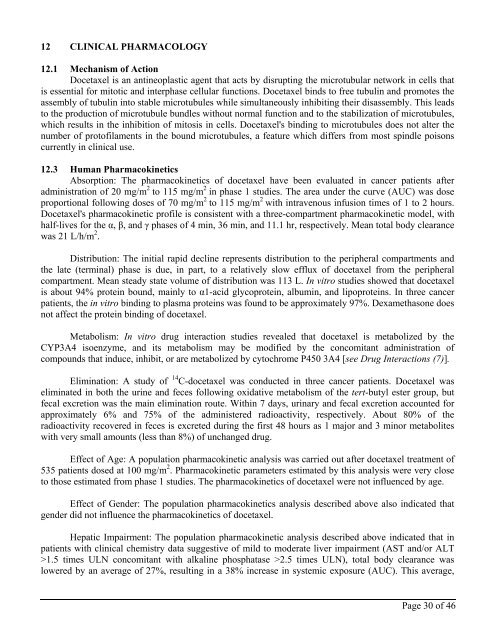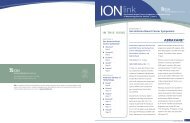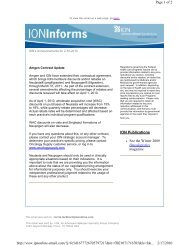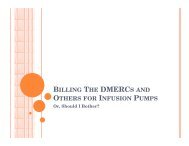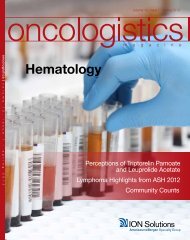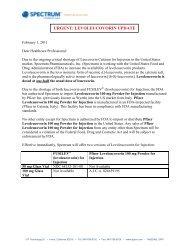Single Vial Docetaxel Injection - ION Solutions
Single Vial Docetaxel Injection - ION Solutions
Single Vial Docetaxel Injection - ION Solutions
Create successful ePaper yourself
Turn your PDF publications into a flip-book with our unique Google optimized e-Paper software.
12 CLINICAL PHARMACOLOGY<br />
12.1 Mechanism of Action<br />
<strong>Docetaxel</strong> is an antineoplastic agent that acts by disrupting the microtubular network in cells that<br />
is essential for mitotic and interphase cellular functions. <strong>Docetaxel</strong> binds to free tubulin and promotes the<br />
assembly of tubulin into stable microtubules while simultaneously inhibiting their disassembly. This leads<br />
to the production of microtubule bundles without normal function and to the stabilization of microtubules,<br />
which results in the inhibition of mitosis in cells. <strong>Docetaxel</strong>'s binding to microtubules does not alter the<br />
number of protofilaments in the bound microtubules, a feature which differs from most spindle poisons<br />
currently in clinical use.<br />
12.3 Human Pharmacokinetics<br />
Absorption: The pharmacokinetics of docetaxel have been evaluated in cancer patients after<br />
administration of 20 mg/m 2 to 115 mg/m 2 in phase 1 studies. The area under the curve (AUC) was dose<br />
proportional following doses of 70 mg/m 2 to 115 mg/m 2 with intravenous infusion times of 1 to 2 hours.<br />
<strong>Docetaxel</strong>'s pharmacokinetic profile is consistent with a three-compartment pharmacokinetic model, with<br />
half-lives for the α, β, and γ phases of 4 min, 36 min, and 11.1 hr, respectively. Mean total body clearance<br />
was 21 L/h/m 2 .<br />
Distribution: The initial rapid decline represents distribution to the peripheral compartments and<br />
the late (terminal) phase is due, in part, to a relatively slow efflux of docetaxel from the peripheral<br />
compartment. Mean steady state volume of distribution was 113 L. In vitro studies showed that docetaxel<br />
is about 94% protein bound, mainly to α1-acid glycoprotein, albumin, and lipoproteins. In three cancer<br />
patients, the in vitro binding to plasma proteins was found to be approximately 97%. Dexamethasone does<br />
not affect the protein binding of docetaxel.<br />
Metabolism: In vitro drug interaction studies revealed that docetaxel is metabolized by the<br />
CYP3A4 isoenzyme, and its metabolism may be modified by the concomitant administration of<br />
compounds that induce, inhibit, or are metabolized by cytochrome P450 3A4 [see Drug Interactions (7)].<br />
Elimination: A study of 14 C-docetaxel was conducted in three cancer patients. <strong>Docetaxel</strong> was<br />
eliminated in both the urine and feces following oxidative metabolism of the tert-butyl ester group, but<br />
fecal excretion was the main elimination route. Within 7 days, urinary and fecal excretion accounted for<br />
approximately 6% and 75% of the administered radioactivity, respectively. About 80% of the<br />
radioactivity recovered in feces is excreted during the first 48 hours as 1 major and 3 minor metabolites<br />
with very small amounts (less than 8%) of unchanged drug.<br />
Effect of Age: A population pharmacokinetic analysis was carried out after docetaxel treatment of<br />
535 patients dosed at 100 mg/m 2 . Pharmacokinetic parameters estimated by this analysis were very close<br />
to those estimated from phase 1 studies. The pharmacokinetics of docetaxel were not influenced by age.<br />
Effect of Gender: The population pharmacokinetics analysis described above also indicated that<br />
gender did not influence the pharmacokinetics of docetaxel.<br />
Hepatic Impairment: The population pharmacokinetic analysis described above indicated that in<br />
patients with clinical chemistry data suggestive of mild to moderate liver impairment (AST and/or ALT<br />
>1.5 times ULN concomitant with alkaline phosphatase >2.5 times ULN), total body clearance was<br />
lowered by an average of 27%, resulting in a 38% increase in systemic exposure (AUC). This average,<br />
Page 30 of 46


